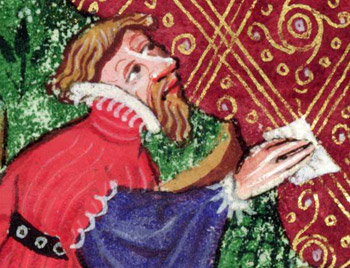Sir Eglamour of Artois
General Information
Plot Summary

Eglamour, a knight, falls in love with Cristabel, the only child of his lord, Princeamour, the Earl of Artois. He bemoans his lower rank to the point of lovesickness, but she reciprocates his feelings and he recovers. Princeamour agrees to give Eglamour Cristabel and his earldom if he performs three feats of arms, which it soon becomes clear that he intends the knight to fail.
Eglamour completes his first task with ease, capturing a deer from the giant Arrok and slaying him in the process. He returns to Artois with Arrok’s head, and Princeamour immediately sends him to kill a boar that is terrorising Sydon, which he does in a gruelling four-day battle. He also rescues the people of Sydon from Arrok’s brother, Marras, who raised the boar and is attempting to abduct their princess, Organate. The grateful King offers Eglamour his crown and his daughter, who gives him a ring and promises to wait fifteen years for him. Eglamour returns to Artois bearing the giant’s head, to the delight of Cristabel and the anger of Princeamour. The couple profess their love and spend the night together. After twenty weeks, Princeamour gives Eglamour his third task: to slay a dragon in Rome. He succeeds, but is wounded and spends the next year being cared for by Diamontowre, the Emperor’s daughter, in her bedchamber.
During this time Cristabel gives birth to a son and her enraged father has them put to sea in a rudderless boat. As soon as they reach land, the child is carried off by a griffin, but is found by the King of Israel who christens him Degrabel and raises him as his heir. The distraught Cristabel travels on to Egypt, where she is taken into the court of the king, her uncle. Eglamour returns to Artois with the dragon’s head and Princeamour, afraid of the knight, retreats into a tower. Eglamour seizes power and departs for the Holy Land, where he lives for fifteen years.
Meanwhile, Degrabel has become a noble knight, whose arms show a child carried by a griffin. The King of Israel suggests that he should marry and they travel to Egypt, where the two Kings arrange a tournament with Cristabel as the prize. Degrabel is victorious, but after they are married Cristabel sees his arms and realises he is her son. The unconsummated marriage is dissolved, and the kings agree that her suitors must beat Degrabel in combat.
This second tournament is attended by Eglamour, bearing his new arms: a ship, a drowning lady and a child. He knocks Degrabel down with the flat of his sword and is declared the winner. Christabel recognises him by his arms, and joyfully introduces Degrabel to his father. The King of Israel tells how he found the child, and the King of Sydon promises Degrabel Organate. They all travel to Artois, where Princeamour falls from his tower and dies. Eglamour and Cristabel are married in the same lavish ceremony as Degrabel and Organate.
From: Harriet Hudson, Four Middle English Romances. Kalamazoo, Michigan: Medieval Institute Publications for TEAMS, 1997.
Manuscript: London, British Library, MS Cotton Caligula A.ii.
Manuscripts
Click a title below to search for all romances in that manuscript.